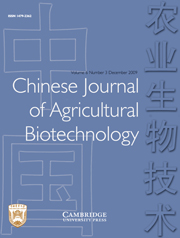Article contents
Isolation and transformation of Trichoderma viride protoplasts
Published online by Cambridge University Press: 12 February 2007
Abstract
The conditions for protoplast isolation and regeneration from Trichoderma viride were studied. Protoplasts were optimally isolated when mycelia of T. viride that had been cultured for 24 h were digested with 4 mg/ml Glucanex in phosphate buffer (pH 6.98) for 4 h at 30°C, resulting in a protoplast yield of 4.7×107 cfu/mg. The maximum regeneration ratio (14.5%) was obtained in mycelia culture medium containing 0.3 mol/l KCl and 0.3 mol/l inositol. In addition, a plasmid pCSSNCC1 carrying a hygromycin resistance gene and an elicitor-producing gene was transformed into T. viride protoplasts, with an efficiency of 1–2 transformants/μg DNA. The hygromycin-resistant transformants were determined by PCR and the elicitor protein was detected by ELISA. The results indicate that the elicitor protein was expressed stably in T. viride.
Information
- Type
- Research Article
- Information
- Copyright
- Copyright © China Agricultural University and Cambridge University Press 2004
References
- 1
- Cited by

